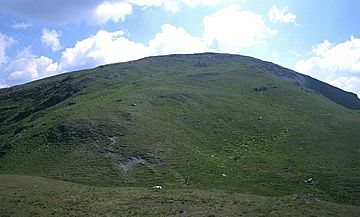Plynlimon facts for kids
Quick facts for kids Pen Pumlumon Fawr |
|
|---|---|

The northern slopes of Pumlumon Fawr
|
|
| Highest point | |
| Elevation | 752 m (2,467 ft) |
| Prominence | 526 m (1,726 ft) |
| Parent peak | Pen y Fan |
| Listing | Marilyn, Hewitt, Council top, Nuttall |
| Naming | |
| English translation | five tops, five beacons |
| Language of name | Welsh |
| Geography | |
| Location | Ceredigion, Wales |
| Parent range | Cambrian Mountains |
| OS grid | SN789869 |
| Topo map | OS Landranger 135 |
| Listed summits of Plynlimon | ||||
| Name | Grid ref | Height | Status | |
|---|---|---|---|---|
| Pen Pumlumon Arwystli | SN815877 | 741 m | Hewitt, Nuttall | |
| Pen Pumlumon Llygad-bychan | SN815877 | 727 m | Hewitt, Nuttall | |
| Y Garn | SN775851 | 684 m | Hewitt, Nuttall | |
| Pumlumon Fach | SN787874 | 664 m | Nuttall | |
| Pumlumon Cwmbiga | SN830899 | 620 m | Deleted Nuttall | |
| Carnfachbugeilyn | SN826903 | 622 m | Unclassified | |
Plynlimon (anglicised from Pumlumon in Welsh) is the highest point of the Cambrian Mountains in Wales (taking the more restricted definition of the Cambrian Mountains, excluding Snowdonia and the Brecon Beacons), and the highest point in Mid Wales. It is a massif that dominates the surrounding countryside and is the highest point (county top) of Ceredigion (both the modern council area, and the historic county, also known as Cardiganshire).
The highest point of the massif itself is Pen Pumlumon Fawr, which is 752 metres (2,467 ft) above ordnance datum. Its other important peaks are Pen Pumlumon Arwystli, Y Garn, Pen Pumlumon Llygad-bychan and Pumlumon Fach.
The longest river in Britain, the River Severn, has its source on the mountain, as do the rivers Wye and Rheidol.
Folklore says there is a sleeping giant in Pumlumon.
Contents
Etymology
Plynlimon is anglicized from the Welsh name Pumlumon, which is thought to mean "five tops" or "five beacons". The first element is Old Welsh pimp, meaning "five" (Modern Welsh pump), and the second is llumon, "beacon", an element whose Brittonic equivalent underlies the Scottish hill-names Lomond Hills and Ben Lomond.
Habitat
The Pumlumon area is the largest watershed in Wales and is the source of the rivers Wye, Severn and Rheidol. Since 2007 the Wildlife Trusts of Wales have been working to improve the habitat as a "living landscape" project. This watershed area has been affected by loss of biodiversity, erosion of the peaty soils' structure, and accelerated drainage. Some believe the drainage issues have contributed significantly to flooding in areas some distance downstream, though this cannot be clearly proved.
Like most of the uplands across Wales, intensive land use activities have resulted in many habitats being either lost or degraded. Over-grazing of sheep has induced soil compaction, which has resulted in increased flooding of the lowland areas. The principal land cover within the project area is dominated by a complex mosaic of locally, nationally and internationally important habitats and species, such as dry and wet dwarf-shrub heathland, blanket bog, unimproved acid grassland and a number of oligotrophic lakes. Agriculturally improved grassland, broadleaved woodlands and forestry plantation are also characteristic features of the area.
The Pumlumon area is also important for breeding, wintering and feeding bird fauna particularly hen harrier, merlin, short-eared owl and red and black grouse, and a number of Red Data Book and UK BAP invertebrates. The red kite also frequents the area. Golden Plovers have declined by 92% since 1992.
Severn Way
The Severn Way runs for 210 miles (337 km) along the River Severn between the mouth of the Severn at Bristol, England, and its source at Plynlumon, Wales.
See also
 In Spanish: Pumlumon para niños
In Spanish: Pumlumon para niños

